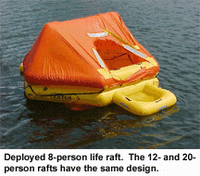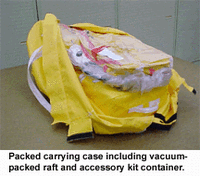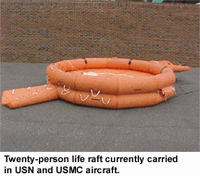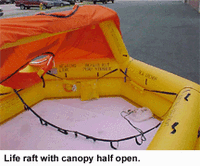Issue 209 - 01 November 99
Issue 209 - 1 November 1999
Printer friendly version.
Multi­Place Life Rafts Acquisition Reform "Principles and Practices in Action"
One of the biggest challenges of today is to find ways to accomplish those extra projects
that would provide improvements to the equipment already in use by our military forces. It seems the shrinking budgets are needed more and more to simply sustain the current tempo of operations with little left over. This is a report on one team's approach to improving one product line for the U.S. Navy and Marine Corps. It includes the pursuit of non-traditional funding sources and the application of Acquisition Reform training.
The product line included the 7, 12, and 20-man Multi-Place Life Rafts (MPLR) currently
carried in many of the USN and USMC aircraft. These rafts were designed in the 1950's. They have been procured since that time using DoD detail specifications, which require now obsolete materials, dated fabrication methods, and the use of Ozone Depleting Substances (ODS). These rafts require scheduled inspections including inflation be conducted every 224 days and which average six hours per inspection. These frequent inspections and the type of raft material significantly reduce the life of the rafts and require their replacement every 5-10 years.
A group from the Naval Air Team I Warfare Center, Aircraft Division (NAWCAD) Patuxent River submitted a proposal to the Aircraft Equipment Reliability and Maintainability Improvement Program (AERMIP) in the Naval Air Systems Command. Another group submitted a proposal to the NAVAIR Affordable Readiness program for funding to identify, qualify, produce procurement packages, and develop logistics support for new rafts. When this program received funding, the two teams were combined with a net reduction in projected program costs.

The new team developed a single Program Plan that would accomplish the goals of both of the original teams. The team applied the lessons learned during recent Acquisition Reform training. It drafted a performance specification that was based upon the FAA Technical Standard Order TSO-C70a for life rafts. However, the specification also included additional requirements necessary to meet the special needs of military aviation. Each of these changes were made to meet those needs while remaining as compatible as possible with existing commercial products and technologies.
The Team has now qualified new 8, 12, and 20 man rafts for fleet use. Operationally they surpass the rafts currently in the fleet today which means downed aircrew and passengers will have a much better chance of surviving a mishap. The three rafts are identical in everything but size, use modern technology, and will save the fleet significant man-hours. The five year scheduled inspection cycle alone will save 77,500 fleet man-hours in the first seven years even with the rafts being introduced on an attrition basis at a rate of 9% per year.
Like any new program, the Team has learned some valuable lessons. The three most significant include Team commitment to Acquisition Reform, pursuing non-traditional funding, and Team composition.
This program has been a challenge, a learning experience, and a lot of hard work to all of the Team members. However, the fleet will soon have a better chance of surviving a mishap while saving time and money over the life cycle of its new life rafts. All told, it was well worth the effort involved.



